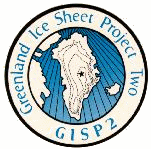
Greenland Ice Sheet Project 2

 |
Greenland Ice Sheet Project 2 |
 |
|
On 1 July 1993, after five years of drilling, the Greenland Ice Sheet Project Two (GISP2,) penetrated through the ice sheet and 1.55 meters into bedrock recovering an ice core 3053.44 meters in depth, the deepest ice core thus far recovered in the world. With the completion of the GISP2 drilling program and a companion European ice coring effort (the Greenland Ice core Project (GRIP), located 28 Km to the east) a new era in paleoenvironmental investigation has been opened. These records are of extreme significance to our understanding of environmental change because they not only provide the highest resolution, continuous, multi-parameter view produced thus far but as importantly the two records can be used to validate each other(e.g., dating, presence of events, length of the environmental record, presence or lack of discontinuities), the only such experiment of this magnitude in ice core research. In late 1988 the Office of Polar Programs (OPP, formerly the division of Polar Programs), of the US. National Science Foundation (NSF) officially initiated GISP2. It was developed as the first in a series of integrated studies, administered by OPP under its Arctic System Science (ARCSS) program, an initiative focusing on environmental change in the Arctic. |
|